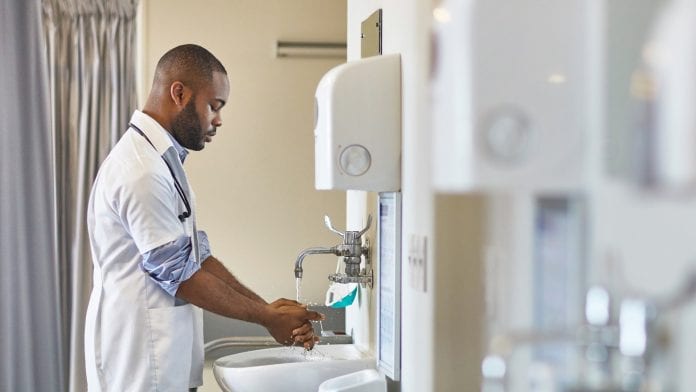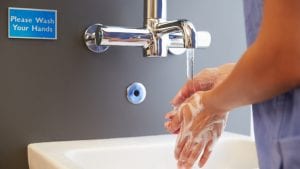
Dr Allison Bartlett, of the University of Chicago, discusses the importance of hand hygiene compliance in clinical settings.
In an April 2021 article for the Journal of the American Medical Association (JAMA), a group of researchers from the University of Chicago detailed the results of an automated hand hygiene compliance monitoring programme at the University of Chicago Medical Center (UCMC) – one of the largest initiatives of its kind in the US – before and during the COVID-19 pandemic. Dr Allison Bartlett, one of the co-authors of the report, speaks to Health Europa Quarterly (HEQ) about the results of the study and hand hygiene compliance in clinical settings.
How does maintaining correct hand hygiene aid in the fight against disease and infection?
We have known that handwashing decreases infection rates since the mid-1800s. It prevents the transmission of bacteria, viruses, and other pathogens from patients to other patients and the surrounding healthcare environment. From Semmelweis’s observations in obstetric units to modern studies (Pittet et al, Lancet 2000;356(9238):1307-12) demonstrating a reduction in nosocomial infections and MRSA transmission, the science around hand hygiene is settled.
What are the main benefits of automated monitoring of hand hygiene compliance?
Automated hand hygiene compliance monitoring has advantages and disadvantages compared with using direct observation. One major advantage is the number of opportunities and events which can be documented. We are able to identify every entry and exit into a patient room and every use of a soap or hand sanitiser dispenser across the institution, 24 hours a day, seven days a week. This can help identify patterns and help us target opportunities: do rates decrease during the night shift? Or the weekends? Is there an afternoon lull?
The data allows us to look at trends over time, since hand hygiene improvement is all about slow, steady progress. It also allows for comparison across units with less concern about ‘cherry-picking’ during direct observation.
It also lets us learn about potential opportunities to streamline workflow for nurses. Are there extra room entries and exits because the correct supplies are not at the bedside? Or is there an opportunity to work with the staff to become more efficient, planning ahead for what supplies they will need when they go into a room?
A downside of aggregated automated hand hygiene monitoring systems is that observations are pooled, and we cannot use the data to determine rates of hand hygiene compliance among specific types of healthcare workers.
What factors could contribute to lowered compliance with hand hygiene protocols? Is complacency an issue, or are clinical staff simply overwhelmed by their workload?
All of the above! Hand hygiene is a habit, and habits can be difficult to develop. If you need to consciously think about performing hand hygiene when you are entering a patient room, it is easy to forget when there are other things on your mind. When hand hygiene is a habit, your mind is freed up to concentrate on other things and the mere act of walking into a room triggers you to perform hand hygiene. The heightened rates during the COVID-19 pandemic are likely due to the fear our healthcare workers had of contracting COVID-19. Over time, teams adjusted to caring for COVID-19 patients and the fear may have decreased.
Your study found an inverse relationship between hand hygiene opportunities and compliance – what could be some reasons for this?
One reason for this has to do with the length of time healthcare workers may be spending in the rooms of patients. The electronic hand hygiene monitoring system denominator is hand hygiene opportunities associated with room entry and room exit, three of the recommended ‘five moments of hand hygiene’ recommended by the World Health Organization (before patient contact; after patient contact; after contact with patient surroundings). There are also hand hygiene events that occur while in the room (before aseptic tasks, after body fluid exposure risk). Especially in intensive care units, the healthcare team spends a lot of time in a patient room completing multiple tasks that could require several hand hygiene events before exiting a room. This effect can be magnified when patients are on isolation. Donning and doffing PPE is time-consuming, so healthcare workers often batch tasks, again leading to multiple hand hygiene events in a room between entry and exit.
In addition, depending on the unit, time of day, day of the week, around 5% of hand hygiene opportunities (room entries and exits) are caused by visitors. While we encourage hand hygiene on room entry and exit by visitors, we hold our healthcare workers to higher standards. During the COVID-19 pandemic we restricted visitation, which cut down on opportunities a little, but our restrictions remained in place well past the closure of our cohort units, so this does not completely explain our findings.

Could targeted hand hygiene messaging campaigns in hospital settings potentially alleviate the drop in compliance?
There has been a lot of research around how best to improve hand hygiene in healthcare settings. Putting up reminder signs works for a while, but that effect extinguishes after about three months. People have tried bells or other audible cues upon room entry and exit to remind staff to perform hand hygiene, but the last thing hospital patients need are more alarms and beeping. We have been working over a period of years with nursing unit leadership through weekly accountability phone calls, and the nursing unit leaders have been working with their staff to build the hand hygiene habit. We use hand hygiene champions, unit-wide pages informing staff when levels dip below a specific threshold, etc. We also engage family members and teach them the importance of hand hygiene to keep themselves and their loved ones safe.
Dr Allison Bartlett
Associate Professor of Paediatrics
Associate Medical Director, Infection Control Programme Paediatric
University of Chicago
hdsi.uchicago.edu/scholars/allison-bartlett-bio/
This article is from issue 18 of Health Europa. Click here to get your free subscription today.











Informative read, Dr.Allison! Hand hygiene can help in preventing infection. However, studies have painted a bleak picture of healthcare workers. They only clean their hands half as often as they should. The result is an increase in health-care-related infections. I believe that automated hand hygiene compliance monitoring is a step in the right direction and may be beneficial in the long run.